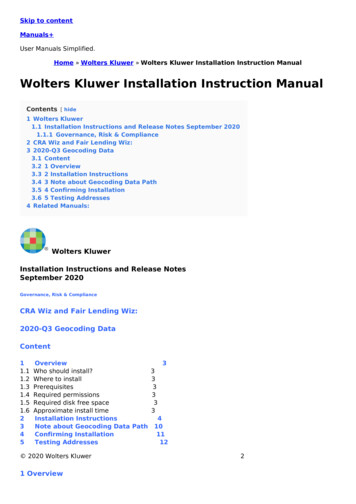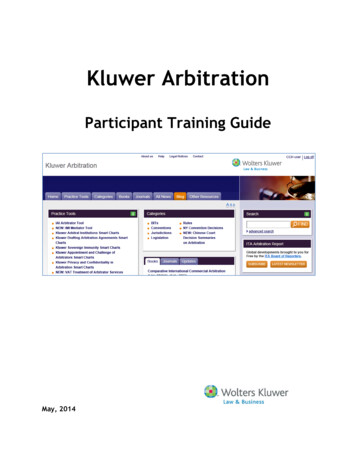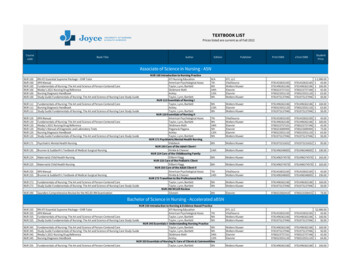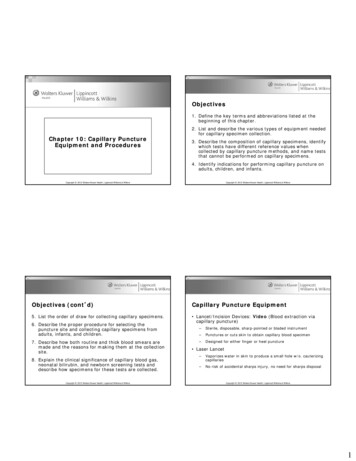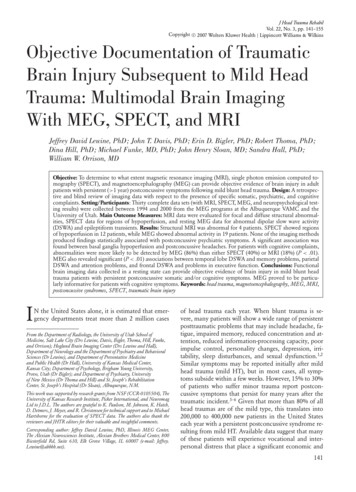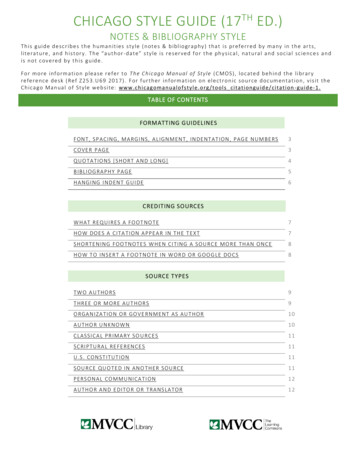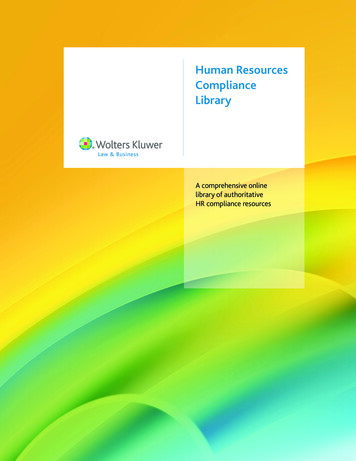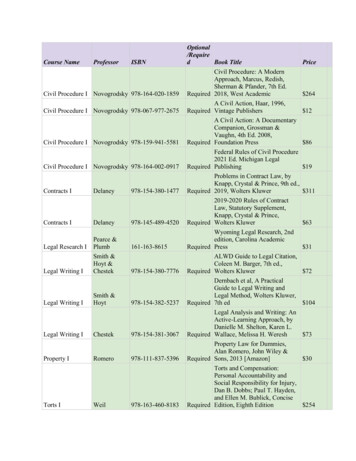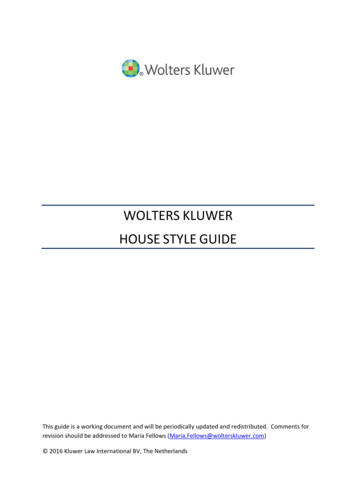
Transcription
WOLTERS KLUWERHOUSE STYLE GUIDEThis guide is a working document and will be periodically updated and redistributed. Comments forrevision should be addressed to Maria Fellows (Maria.Fellows@wolterskluwer.com) 2016 Kluwer Law International BV, The Netherlands
ContentsI.Introduction . 3A.B.II.Online access to the House Style Guide . 3Online access to Kluwer Author Guidelines . 3Punctuation. 4A.B.Apostrophe . 4Colon . 41.2.3.C.Comma. 51.2.D.Lists . 5Numerals . 5Dashes. 61.2.E.F.Interruptions. 6Number Ranges . 6Ellipsis . 6Period. 61.2.G.Abbreviations with a Period . 6Abbreviations without a Period . 7Quotation Marks . 81.2.3.H.III.Blockquote. 4List format . 4Subtitles. 5Single Quotation Marks . 8Double Quotation Marks . 8Quotation Marks and Other Punctuation . 8Square Brackets . 9Mechanics . 10A.Abbreviations . 101.2.3.4.B.Capitalization . 131.2.C.Proper Nouns . 13Titles and Headings . 13Cross References. 131.2.3.D.E.Currency Codes . 10Country Codes . 12Latin Abbreviations . 12Short References. 12Ibid. . 14Id. . 14Op. Cit. and Loc. Cit. . 14Italics . 14Lists . 141
F.Numbers . 151.2.3.G.H.I.Quotations . 15Short References. 16Spelling. 161.1.2.IV.Numerals . 15Ordinal Numbers . 15Spelled Numbers. 15Oxford-z spelling (origin Greek –izein) . 16Compound Words . 17Proper Nouns . 17Citation Style . 18A.B.C.D.E.F.V.Books . 18Periodicals. 18Electronic Sources. 18Case Law . 18International Legislation . 19Foreign Language Text . 19Formatting . 20A.B.C.D.Dates . 20Figures . 20Tables . 20Headings . 202
I.IntroductionThis document defines editorial styles (rules) used to present content for Wolters Kluwerpublications. Authors, editors, Wolters Kluwer departments dealing with content (manuscripts,proofs, XML), and editorial service and project management vendors should consult this documentfor questions regarding Wolters Kluwer editorial style.The following sections included in our Style guidelines outline the rules for presenting English ormattingThe sections on punctuation and mechanics explain when to use certain grammatical elements, likewhen to use a period with an abbreviation or when to use an ellipsis. These sections focus on uniquefeatures of Wolters Kluwer House Style, not basic grammar rules. The citations section explains howto cite references. The formatting section explains how to format the manuscript.A. Online access to the House Style GuideWolters Kluwer House Style Guide can be accessed online on our Author e––Scroll down to the bottom of the page to the ‘Links’ shown in the blue boxClick on ‘House Style Guide (PDF)’ linkB. Online access to Kluwer Author GuidelinesKluwer Author Guidelines can be accessed online on our Author e––Scroll down to the bottom of the page to the ‘Links’ shown in the blue boxClick on ‘Author Guidelines (PDF)’ link3
II.PunctuationA. ApostropheUse 's (apostrophe s) to indicate possession for words that do not end with the letter s. Use only theapostrophe if the word ends with the letter s.Example:Bill's bookIris' bookException:US'sApostrophes are not used to make a date plural.Example:the 1980sB. Colon1. BlockquoteUse a colon before a blockquote.Example:Article 5(2) states:Authorised officers entering premises under a warrant may take with them such equipmentas they deem necessary. This will include equipment that can be used to enter the premisesusing reasonable force (for example, equipment that can be used to break locks) as well asequipment that can be used to facilitate the search (for example, computer equipment).12. List formatUse a colon before a list.Use en-dashes (–) for unnumbered lists (not bullets)Example:In particular, LC lists include the relationships in the following spheres:––organization and management of labour;arrangement of employment at a particular employer (as concerns entering intoemployment relationship);4
Example:–professional training, retraining and professional development of employees directlywith the given employer.Use numbers (or letters) between parentheses for ‘run-in’ lists; items are separated by commas.Example:The lecturers will cover (a) competition tax law, (b) copyright law, and (c) labour law.Compose three sentences showing the use of (1) quotations, (2) en dashes, and (3) colons3. SubtitlesUse a colon (not a dash) between a title and subtitle. This is especially if the TOC is included.Example:The Arab-Israeli Accords: Legal PerspectivesC. Comma1. ListsUse a comma between items in a list. Using a comma between the last two items in a list is optional,unless omitting the comma results in ambiguity or a misreading. If a list includes internalpunctuation, a semicolon can be used instead of a comma.Example:apples, oranges, and bananasExplanationThe comma between last two items ispreferred but not required.tropical fruits such as mangos, papayas, andbananas; root vegetables such as carrots,potatoes, and parsnips; and nutsThere are sub-lists within the main list, sothe main list items are separated with asemicolon.2. NumeralsUse commas in numerals greater than 999, but not in page, paragraph, or section numbers.Example:1,582page 15825
D. Dashes1. InterruptionsUse a spaced en-dash to indicate an interruption in a text.Example:There was a time – and indeed not very long ago – when things were much different.2. Number RangesUse a non-spaced en-dash to indicate to indicate number ranges.Example:2–4204–209E. EllipsisUse an ellipsis to indicate that you have deleted material from a quotation.Example:'This decision only seems to allow a negative conclusion.'Do not use an ellipsis at the beginning of a quotation. Do not use an ellipsis at the end of a quotationunless you have deleted the final words of the quotation.Example:Original text:A provision of this Part which is expressed to apply to, or in relation to, an agreement is to beread as applying equally to, or in relation to, a decision by an association of undertakings or aconcerted practice (but with any necessary modifications).Quotation in manuscript:A provision for section 2(5) on agreements preventing competition applies to 'a decision by anassociation of undertakings or a concerted practice '.F. Period1. Abbreviations with a PeriodUse a period at the end of an abbreviation if the abbreviation is made by truncating the word.6
WordparagraphversusArticlenoteet ceteraAbbreviationpara.v.Art.n.etc.2. Abbreviations without a PeriodDo not use a period at the end of an abbreviation if the abbreviation includes the last letter of theabbreviated nparasArtsMrDrDo not use periods in capital letter abbreviations, including country codes, US states, organizationnames, and currency abbreviations.WordCountry CodesUnited States of AmericaUnited KingdomEuropean UnionEuropean CommunityUS StatesMontanaNew YorkTexasOrganization NamesNorth Atlantic Treaty OrganizationNorth American Free Trade AgreementCurrency CodesUnited States R7
G. Quotation Marks1. Single Quotation MarksUse single quotation marks to indicate quotations roughly four lines long or less.Example:Non-business premises are defined as, 'any premises to which a decision of the Commissionordering the Article 21 inspection relates'.2. Double Quotation MarksUse double quotation marks for quotes within quotes.Example:Section 2(7) of the Competition Act states, '"the United Kingdom" means, in relation to anagreement which operates or is intended to operate only in a part of the United Kingdom, thatpart'.3. Quotation Marks and Other Punctuationa) BlockquotesBlockquotes do not use quotation marks. If a blockquote contains a quote, use single quotationmarks.Example:Section 2(7) of the Competition Act states:In this section, 'the United Kingdom' means, in relation to an agreement which operates or isintended to operate only in a part of the United Kingdom, that part.b) Commas, Colons, and SemicolonsCommas, colons, and semicolons are placed outside the end-quotation mark.Example:Section 2(7) of the Competition Act states, 'In this section "the United Kingdom" means, inrelation to an agreement which operates or is intended to operate only in a part of the UnitedKingdom, that part'; 1 however, c) Periods, Question Marks, and Exclamation MarksPeriods, question marks, and exclamation marks are generally placed outside the end-quotationmark; however, if an entire sentence is quoted (including the initial capital letter), the period,question mark, or exclamation mark may be placed inside the end-quotation mark.8
H. Square BracketsUse brackets when you insert words into a direct quotation.Example:'The European Commission Report [on Article 81] explains '.Use the Latin word 'sic' in brackets to indicate an error in a quoted sentence which appears in thesource material.Example:'The report on misdemeanours give [sic] an overview of the locus of crime around city centres.'9
III.MechanicsA. AbbreviationsAbbreviations, other than short references, should not be used in the body of a text, but may beused in footnotes. Some examples include:TermArticle 1Chapter 9section 2sections 2 and 9subsection (3)subsections (3)-(5)Schedule 8Order 23DecemberAbbreviation in FootnoteArt. 1Ch. 9s. 2ss 2 and 9subs. (3)subss (3)-(5)Sch. 8Ord. 23Dec.1. Currency CodesUse the ISO currency code abbreviations with a space between the abbreviation and numeral. Anup-to-date list of ISO currency codes can be ordered from the ISO website.Example:USD 50EUR aCyprusCzech UR, formerly ATSBHDEUR, formerly BEFCADCNYEUR, formerly CYPCSKDKKEGPEUR, formerly EEKEUR, formerly FIMCurrency NameAustralian DollarEuro, formerly ShillingBahraini DinarEuro, formerly Belgian FrancCanadian DollarYuan RenmibiEuro, formerly Cypriot PoundCzech KorunaDanish KroneEgyptian PoundEuro, formerly KroonEuro, formerly Markka10
CountryFranceGermanyGreeceHong altaMexicoMoroccoNetherlandsNetherlands AntillesNew QatarSaudi ArabiaSingaporeSlovak RepublicSloveniaSouth AfricaSpainSri LankaAbbreviationEUR, formerly FRFEUR, formerly DEMEUR, formerly GRDHKDHUFISKINRIDREUR, formerly IEPEUR, formerly ITLJPYKESKWDLVLLTLEUR, formerly LUFMWKMYREUR, formerly MLTMXNMADEUR, formerly NLGANGNZDNOKOMRPKRPDPPLNEUR, formerly PTEQARSARSGDEUR, formerly SKKEUR, formerly SITZAREUR, formerly ESBLKRCurrency NameEuro, formerly French FrancEuro, formerly Deutsche MarkEuro, formerly Greek DrachmaHong Kong DollarForintIcelandi KrónaIndian RupeeRupiahEuro, formerly PuntEuro, formerly Italian LiraYenKenyan ShillingKuwaiti DinarLatsLitasEuro, formerly Luxembourg FrancMalawian KwachaRingitt, Malaysian DollarEuro, formerly Maltese LiraMexican New PesoMoroccan DirhamEuro, formerly Dutch GuilderNetherlands Antilles GuilderNew Zealand DollarNorwegian KroneOmani RialPakistani RupeePhilippines PesoNew ZlotyEuro, formerly Portuguese EscudoQatari RiyalSaudi RiyalSingapore DollarEuro, formerly Slovak KorunaEuro, formerly TolarRandEuro, formerly Spanish PesetaSri Lankan Rupee11
d Arab EmiratesUnited PUSDZWDCurrency NameSwedish KronaSwiss FrancBahtTunisian DinarTurkish LiraUnited Arab Emirates DirhamUnited Kingdom Pound, pound SterlingUnited States DollarZimbabwe Dollar2. Country CodesVisit the ISO website for a current list of country codes3. Latin AbbreviationsLatin abbreviations are appropriate in footnotes and bibliographies. Most Latin abbreviations havebecome anglicized and are not italicized.Latin Abbreviationcf.e.g.et al.etc.i.e.N.B.Latin Wordconferexempli gratiaet aliiet ceteraid estnota beneEnglish Equivalentcomparefor exampleand othersand so forththat isnote well4. Short ReferencesA short reference is used when an abbreviated name will be used throughout a text. To introduce ashort reference, use the entire name followed by the abbreviation in parentheses the first time thename is used.TermAbbreviationCollective Labour AgreementCLAGreen Paper on the Review of the Green PaperConsumer AcquisIntroduction of AbbreviationCollective Labour Agreement (CLA)Green Paper on the Review of theConsumer Acquis (hereinafter ‘GreenPaper’)12
B. Capitalization1. Proper NounsCapitalize proper nouns that are specific names for people, organizations, places, or things. Alwayscapitalize the phrase Member State(s).When some general nouns are followed by a number, the term becomes a proper noun. However,the words paragraph, section, subsection, page, and footnote do not become proper nouns whenfollowed by a number.General NounchapterarticlecasescheduleProper Noun with a NumberChapter 9Article 20Case No. C-33/90Schedule 52. Titles and HeadingsCapitalize all words in titles and headings except for articles (a, an, the); conjunctions (and, but, or)and prepositions (on, at, in). The first and last words of titles, subtitles, and headings are alsocapitalized.a) Compound WordsAll initial letters in compound words are capitalized.Example:Cross-Borderb) Hyphenated WordsOnly the initial letter of a hyphenated word is capitalized in titles and headings.Example:Pre-existingC. Cross ReferencesCross references refer the reader to other parts of the same publication and should refer to specificheading numbers or footnote numbers. Cross references should not refer to page numbers.Example:See G. Born, International Commercial ArbitrationSee also section 1.1.1 supra as outlined in Chapter 5 below.13
Be consistent in the use of either supra and infra (in italics) or 'above' and 'below' (not italicized).‘See’, and ‘See also’ are always italicized.1. Ibid.Ibid. (the abbreviation for ibidem) may be used in footnotes; it refers to the citation immediatelypreceding it and may only be used if the immediately preceding footnote contains no more than onecitation. Ibid. takes the place of the entire citation and may be followed by a page number.2. Id.Id. (the abbreviation for idem) should be used sparingly. It may be used to replace either the author'sname in a list of titles by the same author in one and the same footnote, or in the title of the workimmediately preceding, but not both the author and the title (which is reserved for ibid.).3. Op. Cit. and Loc. Cit.The terms op. cit. and loc. cit. should not be used.D. ItalicsItalicize the following:– words the author chooses to emphasize;– case names, including the v. (Wade v. Roe);– foreign words, except for words that have become anglicized.The following list of words should not be italicized in legal writing. Consult Black's Law Dictionary fora complete list of anglicized legal terms.ad hocamicus curiaecertioraride factode jurede novodicta, dictume.g.,en bancet al.et seq.etc.habeas corpusi.e.,in personamin rempassimprima faciequantum meruitquid pro quores gestaeres ipsa loquiturres judicataE. ListsUse an en-dash (–) for an unnumbered list, for short lists, and for lists where numbering wouldsuggest an unintended hierarchy.Where numbering is appropriate, lists and sub-lists should preferably be numbered in the followingway:level 1: (1), (2), (3) 14
level 2: (a), (b), (c) level 3: (i), (ii), (iii) In all cases, lists must have at least two list items. List items should be punctuated either as fullsentences (use an initial capital letter and end with a period) or as phrases (use a lower case letter tobegin the item and a semicolon at the end of each line item, with a period after the last list item. It isacceptable to use and or or between the penultimate and final list item.F. Numbers1. NumeralsUse numerals for:– numbers greater than ninety-nine;– dates and times;– statistics (including decimals, percentages (15%), ratios, ages of people, monetaryfigures);– numbers in a series (5, 10, and 250 years);– number spans (2–4; 204–209).2. Ordinal NumbersDo not use superscript for ordinal numbers: 1st, 2nd, 3rd, etc.3. Spelled NumbersSpell out the following numbers:–––––numbers from zero to ninety-nine;write out the century number (nineteenth century);round numbers like hundred or thousand;fractions;numbers that begin a sentence.G. QuotationsQuotations must be verbatim from the original source. Short quotations should be embedded in thetext; if a quotation extends more than roughly four lines, use blockquote formatting.If the source material contains an error, this can be indicated by the use of '[sic]'. See sections 2.2and 2.6 above for more information about how to use brackets and ellipsis to correctly indicatechanges in a quotation.Denote any emphasis using the parenthetical phrase '(emphasis original)' or '(emphasis added)' atthe end of the quotation.Specify if the quoted material is translated, and whether it has been translated by the author orsomeone else.15
Permissions to reproduce relevant material should always be sought. Consult the author guidelinesto ensure that you comply with copyright regulations. If you have questions about this, pleasecontact the developmental editor.H. Short ReferencesThe first time you cite a source, use the full citation in the footnote. Subsequent references use:Author’s Last Name (or, if not available, Title), supra n. Note Number, at Pinpoint reference.Always include a bibliography or list of references if you use short references.Example:1Joost Pauwelyn, Conflict of Norms in Public International Law: How WTO Law Relates to OtherRules of International Law (New York: Cambridge University Press, 2003), 264.2Pauwelyn, supra n. 1, at 258.Short references to legislation should always include the name, number, and year.I. SpellingSet the language in Word to English (UK) unless American spelling should be used.1. Oxford-z spelling (origin Greek –izein)Refer to the Concise Oxford Dictionary; see also Oxford Dictionaries online(http://oxforddictionaries.com).a) Rule for -ize SuffixOxford spelling takes British spelling of words in combination with the suffix -ize in place of -ise(which has been in more general usage in recent decades). Nevertheless, the form -ize has been inuse in British spelling since medieval times.Suffix forming verbs meaning:to make or becomecause to resembleto treat in a specified wayto perform or subject (someone) to a specified practiceOxford-z spelling ) Rule for Words Ending in -yseWords ending in -yse are not changed by the above rule.Examples:analyseparalyse16
Examples:catalysec) Obligatory -ise spellingThe forms -ize and -ise are, in many cases, straightforward spelling variants. In certain cases, though,the -ise spelling is obligatory.When to use (-ise) spelling:Where it forms part of a larger word elementExamples:compromiseexerciseIn verbs corresponding to nouns with -s- in the stemadviseadvertisetelevise1. Compound WordsHyphens are used for compound words that function as an adjective immediately preceding a noun.Example:nurse-assisted living2. Proper NounsProper nouns, including the names of organizations, retain original spelling.17
IV.Citation StyleKluwer Law International has adopted the Association of Legal Writing Directors (ALWD) legalcitation style to ensure uniformity, which is becoming increasingly critical for content that appearsonline. Below are some examples of common citation.A. BooksThe full citation to a treatise, book or other nonperiodic work may contain up to eight components.Author, Title Pinpoint reference(s) (Editor [if any] , Translator [if any] , Edition [if any] ,Publisher Date).Example:Charles Alan Wright, Arthur R. Miller & Mary Kay Kane, Federal Practice and Procedure vol. 7A,§ 1758, 114-115 (3d ed., West 2005).B. PeriodicalsCitations to articles in journals, law reviews, newspapers, newsletters, and other periodicals typicallycontain seven components.Author, Title, Volume number Periodical abbreviation Initial page , Pinpoint page (Date).Example:L. Ray Petterson, Legal Ethics and the Lawyer’s Duty of Loyalty, 29 Emory L.J. 909, 915 (1980).C. Electronic SourcesA full citation to an internet site contains six components.Author or Owner, Title, Pinpoint reference [if available] , URL (Access or update information Exacedate).Example:ABA Ctr. for Hum. Rights, Rule of Law Letter /roll/history.hmtl (accessed 5 Sept. 2009).D. Case LawCases should be compiled in a reference table. A full citation for a case may contain as many as ninecomponents. However, some citations will contain fewer components.Case Name, Report
This document defines editorial styles (rules) used to present content for Wolters Kluwer publications. Authors, editors, Wolters Kluwer departments dealing with content (manuscripts, proofs, XML), and editorial service and project management vendors should consult this document for questions regarding Wolters Kluwer editorial style.
